A Diode Pumped Middle Infrared Laser Based on Ho: GdVO4 Crystal
Abstract
:1. Introduction
2. Crystals and Lasers
2.1. Characteristics of Ho: GdVO4 Crystal
2.2. Experimental Setup
3. Experimental Results and Discussion
4. Conclusions
Author Contributions
Funding
Institutional Review Board Statement
Informed Consent Statement
Data Availability Statement
Acknowledgments
Conflicts of Interest
References
- Geng, J.H.; Wang, Q.; Jiang, S.B. 2μm fiber laser sources and their applications. Proc. SPIE Int. Soc. Opt. Eng. 2011, 8164, 3–14. [Google Scholar]
- Dirk, T.K.; Verena, O.; Ralf, B.; Robert, K. Potential of a new cw 2 μm laser scalpel for laparoscopic surgery. Med. Laser Appl. 2007, 22, 139–145. [Google Scholar]
- Ilya, M.; Fabian, W.; Alexander, O.; Lawrence, S.; Pankaj, K.; Martin, R. Welding of polymers using a 2 μm thulium fiber laser. Opt. Laser Technol. 2012, 44, 2095–2099. [Google Scholar]
- Martin, S.; Gerhard, S.; Marc, E. Mid-infrared ZGP OPO with divergence compensation and high beam quality. Opt. Express 2018, 26, 1402–1410. [Google Scholar]
- Duan, X.M.; Yao, B.Q.; Song, C.W.; Gao, J.; Wang, Y.Z. Room temperature efficient continuous wave and Q-switched Ho: YAG laser double-pass pumped by a diode-pumped Tm: YLF laser. Laser Phys. Lett. 2008, 5, 800–803. [Google Scholar] [CrossRef]
- Duan, X.M.; Yao, B.Q.; Li, G.; Wang, T.H.; Yang, X.T.; Wang, Y.Z.; Zhao, G.J.; Dong, Q. High efficient continuous wave operation of a Ho:YAP laser at room temperature. Laser Phys. Lett. 2009, 6, 279–281. [Google Scholar] [CrossRef]
- Loconsole, A.M.; Falconi, M.C.; Portosi, V.; Prudenzano, F. Numerical design of a gain-switched pulsed laser at 3.92 μm wavelength based on a Ho3+-doped fluoroindate fiber. J. Lightwave Technol. 2021, 39, 3276–3283. [Google Scholar] [CrossRef]
- Xavier, M.; Samir, L.; Karsten, S. Holmium thin-disk laser based on Ho: KY(WO4)2/KY(WO4)2 epitaxy with 60% slope efficiency and simplified pump geometry. Opt. Lett. 2017, 42, 3490–3493. [Google Scholar]
- Duan, X.M.; Shen, Y.J.; Gao, J.; Zhu, H.B.; Qian, C.P. Active Q-switching operation of slab Ho: SYSO laser wing-pumped by fiber coupled laser diodes. Opt. Express 2019, 27, 11455–11461. [Google Scholar] [CrossRef] [PubMed]
- Duan, X.; Wu, J.; Dou, R. High-power actively Q-switched Ho-doped gadolinium tantalate laser. Opt. Express 2021, 29, 12471–12477. [Google Scholar] [CrossRef] [PubMed]
- Mikhailov, V.A.; Zavartsev, Y.D.; Zagumennyi, A.I.; Ostroumov, V.G.; Studenikin, P.A. Tm3+: GdVO4—A new efficient medium for diode-pumped 2-μm lasers. Quantum Electron. 1997, 27, 13–14. [Google Scholar] [CrossRef]
- Higuchi, M.; Kodaira, K.; Urata, Y. Float zone growth and spectroscopic characterization of Tm: GdVO4 single crystals. J. Cryst. Growth 2004, 265, 487–493. [Google Scholar] [CrossRef]
- Urata, Y.; Wada, S. 808-nm diode-pumped continuous-wave Tm: GdVO4 laser at room temperature. Appl. Opt. 2005, 44, 3087–3092. [Google Scholar] [CrossRef] [PubMed]
- Esser, M.J.D.; Preussler, D.; Bernhardi, E.H. Diode-end-pumped Tm: GdVO4 laser operating at 1818 and 1915 nm. Appl. Phys. B 2009, 97, 351–356. [Google Scholar] [CrossRef]
- Ge, P.G.; Liu, J.; Jiang, S.Z.; Xu, Y.Y.; Man, B.Y. Compact Q-switched 2 μm Tm: GdVO4 laser with MoS2 absorber. Photonics Res. 2015, 3, 256–259. [Google Scholar] [CrossRef] [Green Version]
- Yao, B.Q.; Ding, Y.; Duan, X.M.; Dai, T.Y.; Ju, Y.L.; Li, L.J.; He, W.J. Efficient Q-switched Ho: GdVO4 laser resonantly pumped at 1942 nm. Opt. Lett. 2014, 39, 4755–4757. [Google Scholar] [CrossRef] [PubMed]
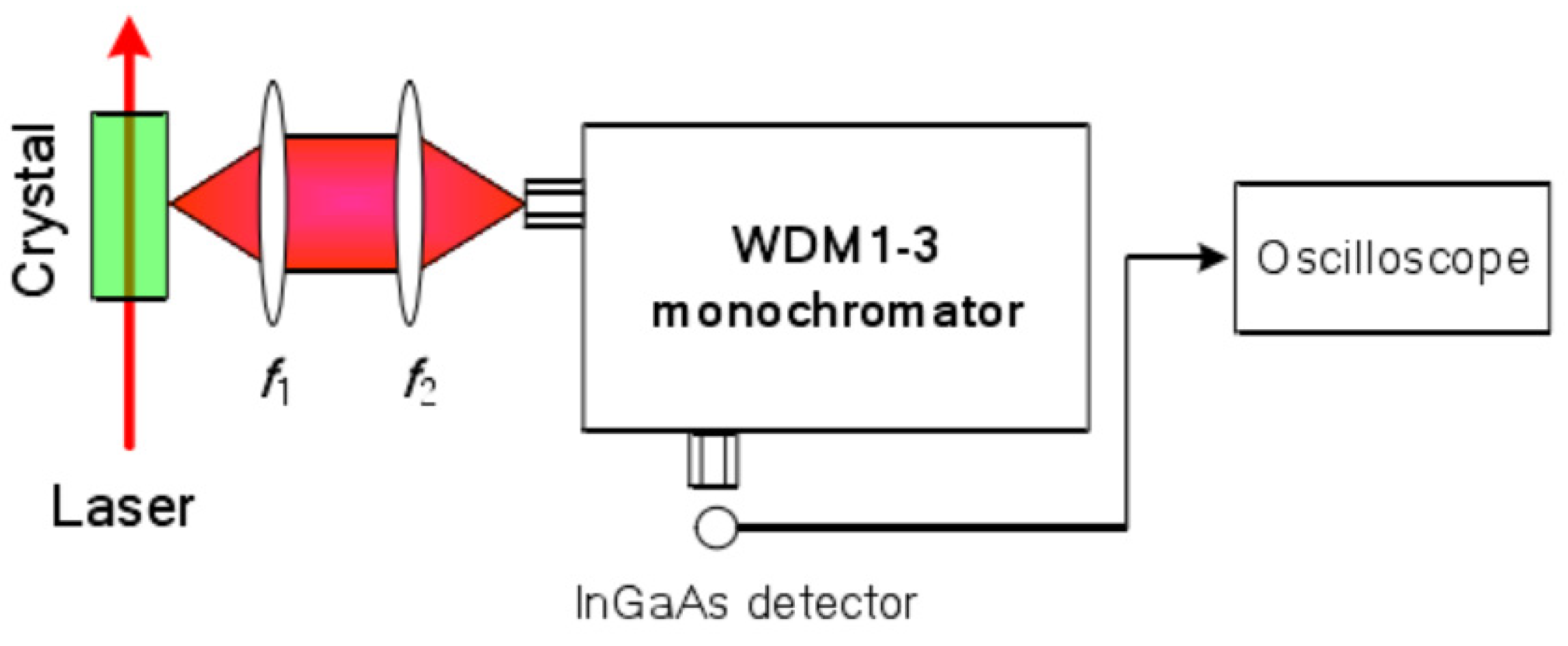

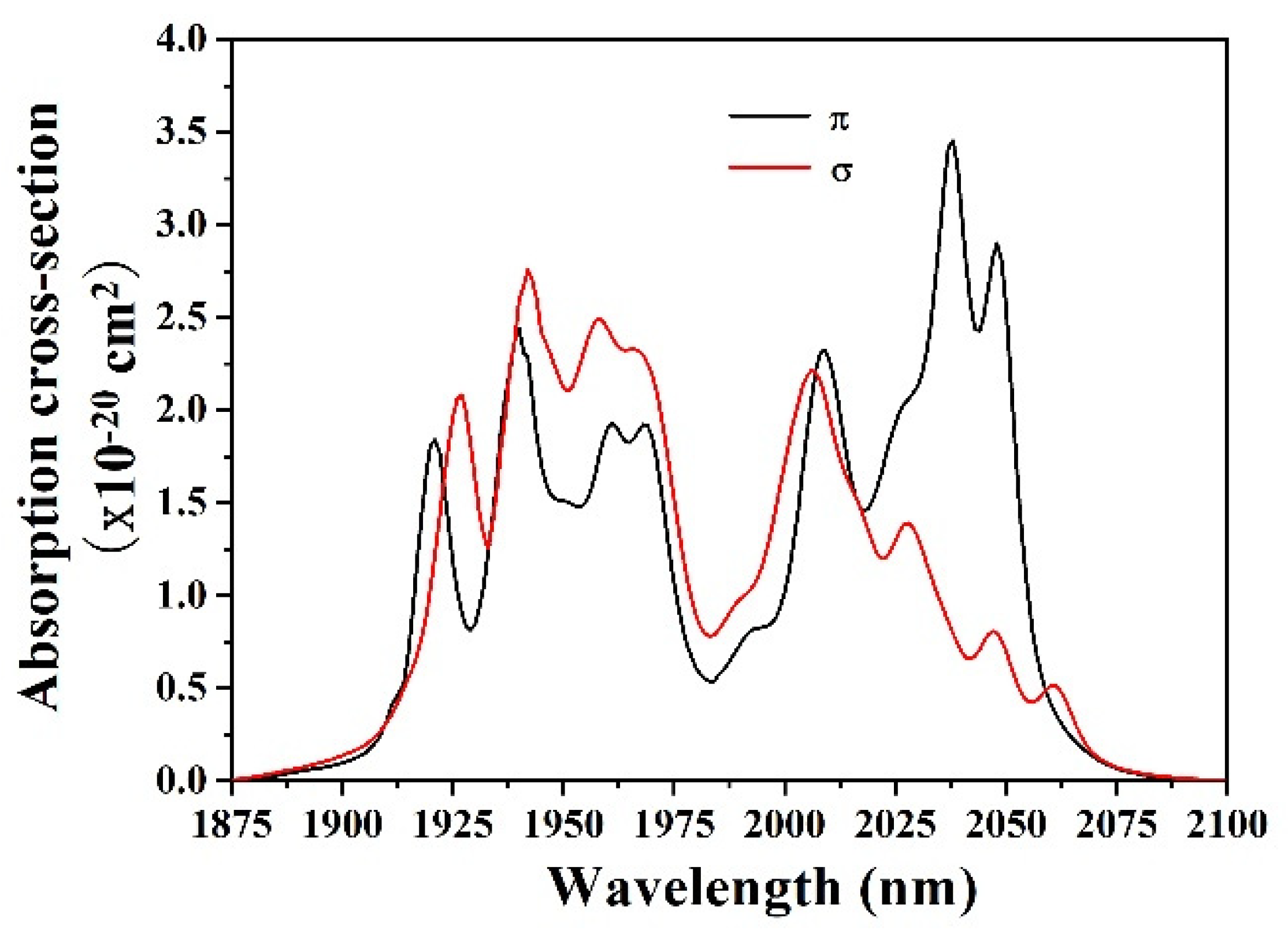

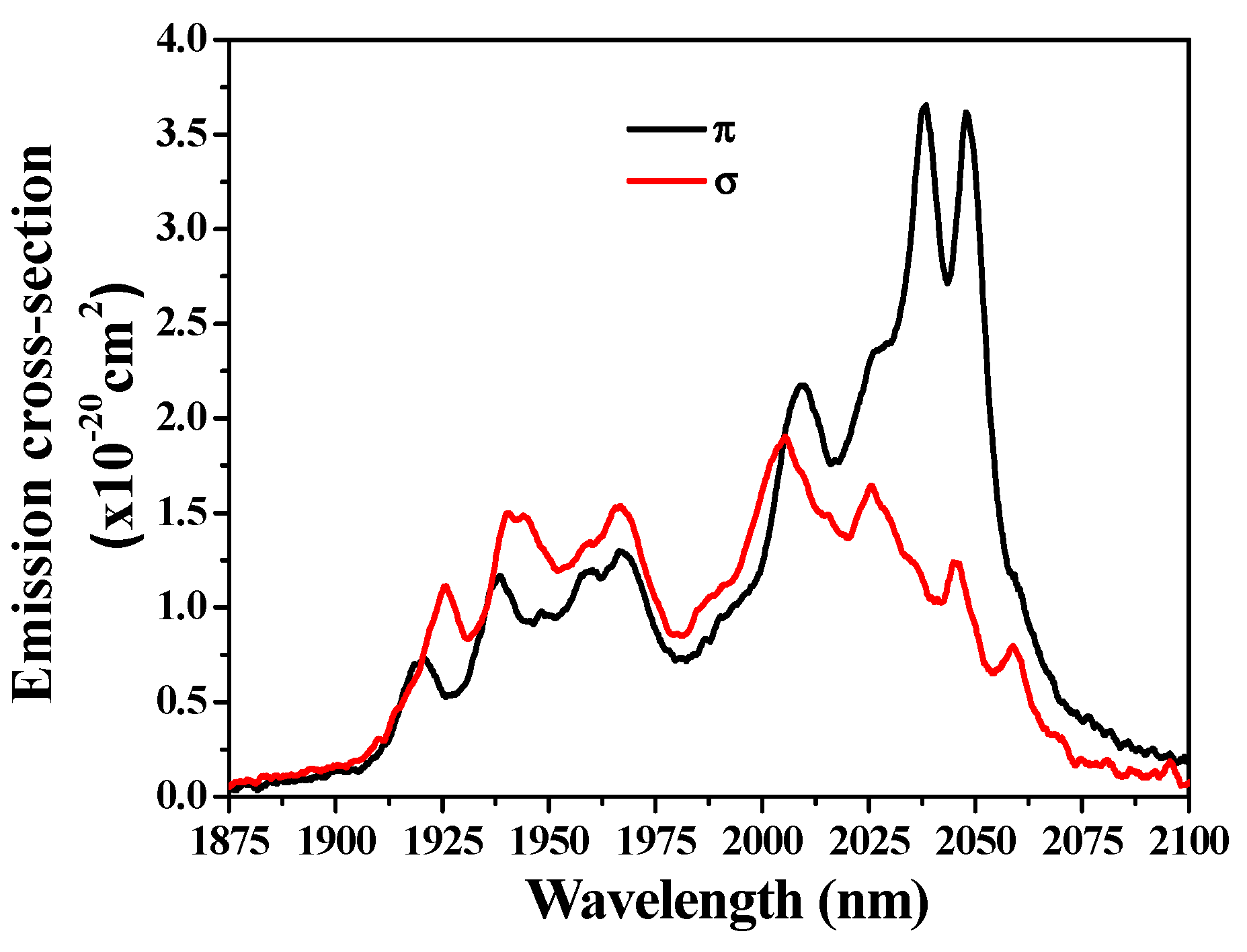


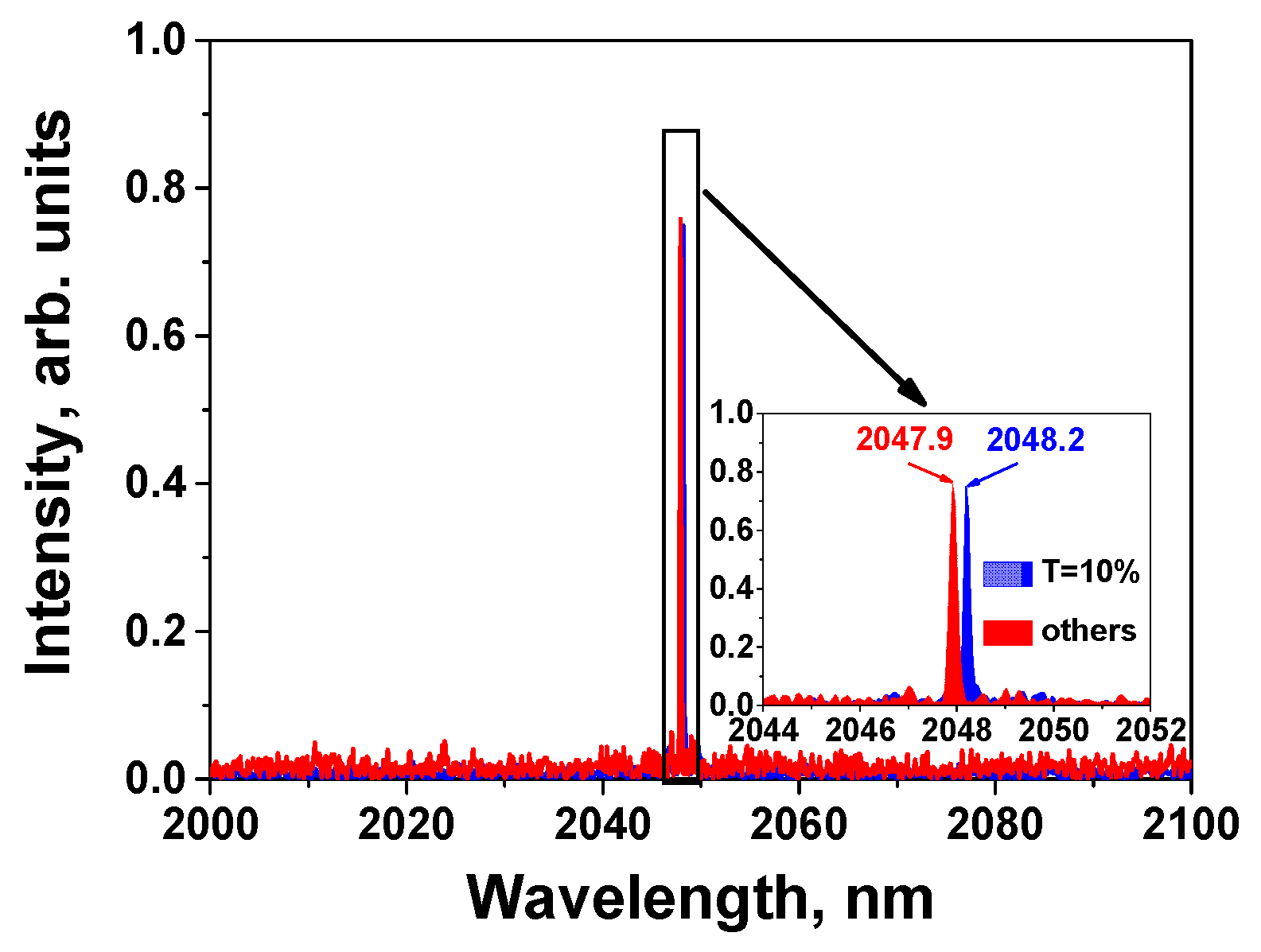
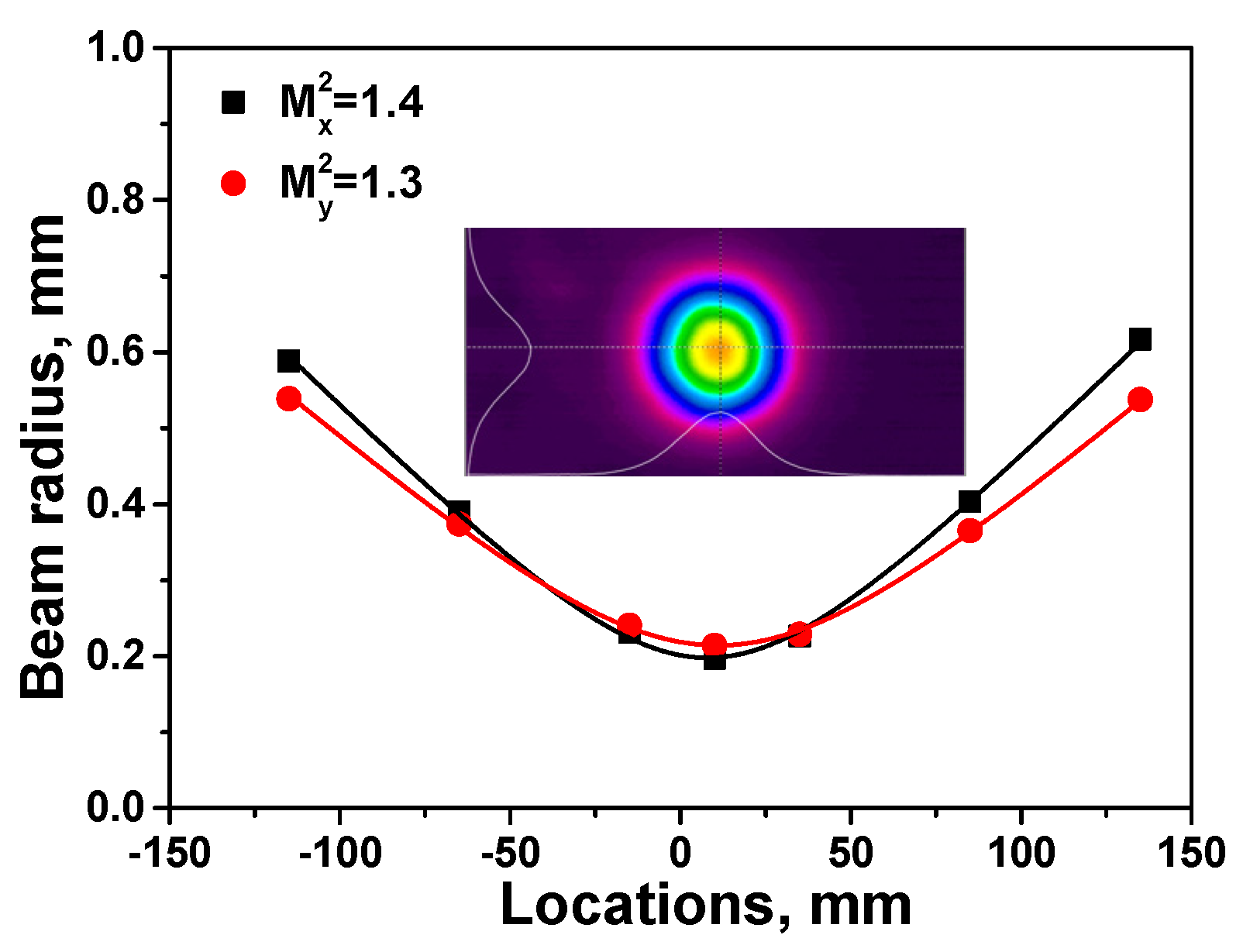
Publisher’s Note: MDPI stays neutral with regard to jurisdictional claims in published maps and institutional affiliations. |
© 2021 by the authors. Licensee MDPI, Basel, Switzerland. This article is an open access article distributed under the terms and conditions of the Creative Commons Attribution (CC BY) license (https://creativecommons.org/licenses/by/4.0/).
Share and Cite
Ding, Y.; Liu, T.; Yan, M. A Diode Pumped Middle Infrared Laser Based on Ho: GdVO4 Crystal. Appl. Sci. 2021, 11, 11537. https://doi.org/10.3390/app112311537
Ding Y, Liu T, Yan M. A Diode Pumped Middle Infrared Laser Based on Ho: GdVO4 Crystal. Applied Sciences. 2021; 11(23):11537. https://doi.org/10.3390/app112311537
Chicago/Turabian StyleDing, Yu, Tongyu Liu, and Mengmeng Yan. 2021. "A Diode Pumped Middle Infrared Laser Based on Ho: GdVO4 Crystal" Applied Sciences 11, no. 23: 11537. https://doi.org/10.3390/app112311537




